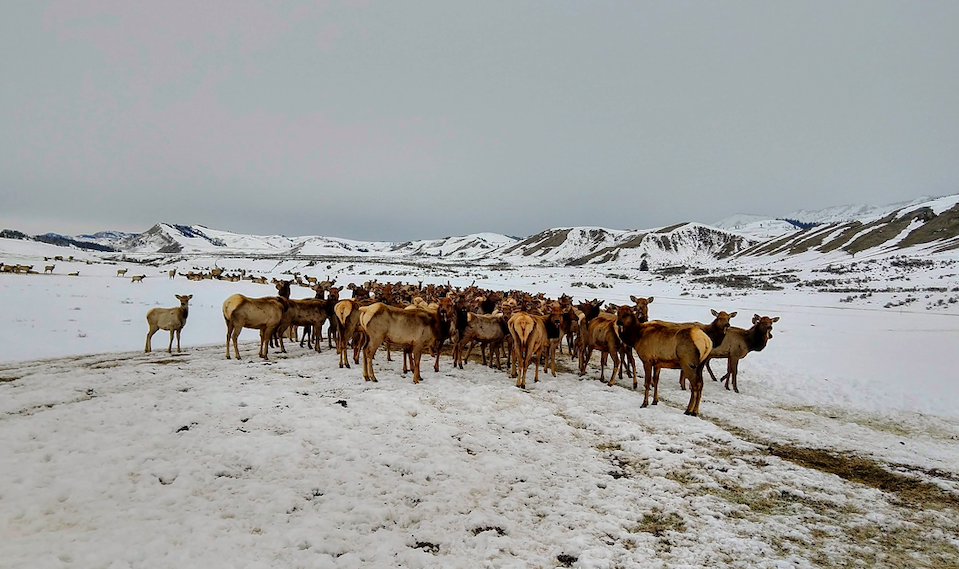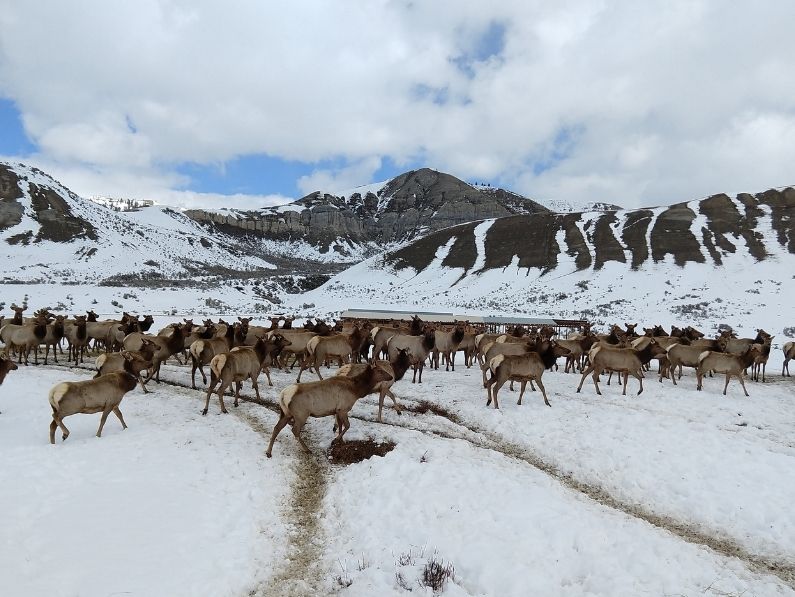Chronic Wasting Disease has arrived in Northwest Wyoming’s elk population for the first time. The Fish and Game Department confirmed last week that the disease, abbreviated as CWD, was found in an elk in Grand Teton National Park. Experts warn that local herds could be potentially susceptible to the spread of CWD, as they concentrate in feedgrounds west of the Continental Divide during the winter, unlike elsewhere. Some activists have called for the elimination of these feedgrounds, but that would mean a complete disruption of a practice that has been in existence since 1912. One that maintains the delicate balance between wildlife sustainability and human influence. Now, it seems there are only wrong answers in a conundrum where thousands of ungulate lives, and tourism dollars, may be on the line.
Angus Thuermer of the nonprofit news service WyoFile reported on how Wyoming Game and Fish is preparing for CWD in its feedgrounds earlier this month. I asked him why the disease, which is similar to Mad Cow Disease, could be so detrimental to elk herds in Jackson Hole and surrounding counties.
Thuermer: You can’t treat it, there’s no vaccine to prevent it, and it’s always fatal. So this is a very serious matter, and it doesn’t show up immediately if an elk, for example, gets CWD. It takes, I believe, a couple of years to show itself. And so an animal who is infected may be spreading it for some time before it shows what they call clinical signs of Chronic Wasting Disease, which are lethargy, saliva, and droopy ears, and things like that. The animal wastes away.
Walkey: Have you seen an elk suffering from Chronic Wasting Disease before? What does that look like?
Thuermer: It’s very sad scene. Droopy heads. Droopy ears. Salivating. Thin. Emaciated. Wasting is the best description of it.
Walkey: How soon are we to Chronic Wasting Disease infecting some of these large herds near Jackson Hole?
Thuermer: As far as you can throw a baseball. That’s how close it is. You can stand on the road in the Gros Ventre and throw a stone from Grand Teton National Park into the National Elk Refuge. That’s essentially how close CWD is to the National Elk Refuge supplemental feeding program, and essentially the feedgrounds in the rest of the state. It’s a stone’s throw away if it hasn’t arrived already. Experts believe it’s when and not if. Already Game and Fish has plans for its 22 feedgrounds that seek to minimize the transmission of disease.
Walkey: Can you just go into some of the repercussions of CWD’s spread to Northwest Wyoming?
Thuermer: Its arrival west of the Continental Divide among elk on a feedground is something that’s going to have widespread repercussions for tourism, for recreation, and for hunting. One of the state specialists in disease says once it’s here, it’s going to be impossible to eradicate. So it’s really a dilemma.
Walkey: And how could the presence of feedgrounds potentially affect the spread of Chronic Wasting Disease in local herds?
Thuermer: As everybody is beginning to understand with COVID-19, crowded conditions lead to disease spread. And elk are artificially concentrated on feedgrounds and on the National Elk Refuge. Conservationists have called for closing feedgrounds for some time now, understanding that it is a vector of disease. But the feedground situation is very complicated. Game and Fish said there will be no feedground closures in the near future, and that means ten years.
Walkey: Why do we still have feedgrounds here?
Thuermer: The feedgrounds serve to separate elk from cattle that are fed. They serve to sustain the numbers that are enjoyed by hunters, recreationists, and wildlife watchers, and they serve to keep elk off the highway. They also serve to reduce what’s known as animal damage for which Wyoming Game and Fish is responsible. So, what would happen if feedgrounds were eliminated? My goodness, you would have a big tangle with agriculture. You would have a reduced elk population more than likely, and you would have probably fewer opportunities to see elk in their natural environment. You might have a more healthy elk herd, though. That’s the other side of the equation.
Walkey: It really feels like such a lose-lose situation here, and I guess I’m wondering if it’s even possible to eliminate feedgrounds?
Thuermer: There are so many things that have changed since about 1912 when the feeding first began, that you’d have a mammoth undertaking. You have elk that have been reliant on feedgrounds for 110 years or so, and have modified all their behavior, and to turn back the clock would be very difficult. Game and Fish, I think it was in the 1940s, tried to reestablish an elk migration from Jackson Hole to the Red Desert by trapping a bunch of elk on the refuge, shipping them down to the Red Desert, and hoping they would migrate back up to Jackson Hole. Maybe even all the way to Yellowstone in the spring. And the elk that they trapped and moved down to the Red Desert had a really good time in the Red Desert. And now we’ve got a Red Desert elk population, which is marvelous, but it did not reestablish the migration.
Walkey: This has been a really interesting story to talk about, Angus, and I’m wondering, as someone who reported on this story, is there anything I’m missing here that you’d like to talk about?
Thuermer: There’s a tremendous interest in the elk in Wyoming, and to think that it might be infected with this disease that possibly could have severe impacts is disturbing and frightening. Right now, I have an elk in the freezer, and I’m on pins and needles waiting to see how the CWD test comes back. Negative or positive. I mean, I really, really don’t think that CWD has infected this elk, which I shot west of the Continental Divide. But I’m trying not to eat any before I get the results back.
Walkey: Thank you so much for taking the time to talk with me, Angus. It was a pleasure to meet you.
Thuermer: Thank you. You too, Will. Take care.

A wapiti feedground west of the Continental Divide. (Emily Cohen/KHOL)





